The story of Benny Fields is only half a story without talking about his long-time partner and second wife Blossom Seeley. The second part of this biography includes a lot of information on Blossom, but consider also reading her biography for more background, and to understand why her relationship with Benny was so important to their mutual success. Some of the details here are presented for the first time, in part because not too much has been written on Benny Fields in the past, and also due to new information uncovered in the research for this biography.
Early Years
Benjamin Geisenfeld, born in 1894 in Milwaukee, Wisconsin, to German immigrants Louis and Rosa Geisenfeld, cited as "pioneer residents" of that city, was the youngest of six children, including Bertha (1879), Sam (1882), Bella (1886), Herman (1888) and Lillie (1892).
Louis worked as a wholesale clothing merchant in Milwaukee. While Bennie's 1917 draft record indicates a birth year of 1893, and his 1942 draft record shows one of 1895, 1894 is the actual year as per his Wisconsin birth record. Bennie worked as a newsboy for the Milwaukee Journal and played cornet with their band. He also dabbled in oil painting with some success, and some of his pictures hung in the Lapham Park social center for a time. Bennie initially attended the 4th Street School, followed by North Division High School, playing cornet in the school band as well.
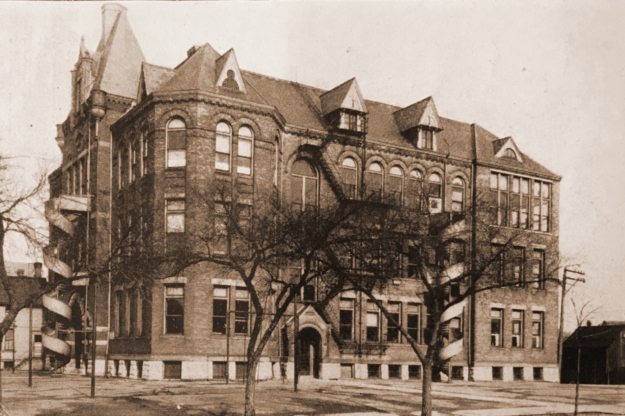 |
It is not certain when he started, but by the time he was graduated from high school in 1912, working at times as Bennie Garfield, then Bennie Fields, he was singing his way up the ladder through dives, night spots, and eventually vaudeville theaters in Chicago. Among these locations was entrepreneur Al Tierney's Cafe on 22nd street, and perhaps Tierney's Grand Auto Inn at 338 East 35th Street. Both were located in predominantly black neighborhoods, but catered to a mixed clientele. It was believed that a rare occurrence of mixed bands also played at these spots. Benny most likely sang popular ragtime tunes of the day with a pianist or a small ensemble. Among those he crossed paths with in Chicago was a young Benny Goodman. After some time at these restaurants Benny started to gain some traction which got him gigs on the vaudeville stage, including the fairly open Hopkins Theater on State Street which hosted amateur nights.
Fields' style was, simply put, crooning. In fact, in later years, Bing Crosby paid tribute to Benny as the original crooner, one who actually influenced the style of many who followed, including himself and Frank Sinatra. His stage presence, however, was more easygoing than it was commanding, which could be viewed as a glass ceiling in vaudeville. Just the same, according to his 1917 draft record, Benny was living in Chicago and by now working the Orpheum circuit in vaudeville, still as Bennie Garfield. The record also shows him as married, although details about his first marriage were difficult to track down. He claimed exemption from the military on account of "bad eyes." Since he was listed as an actor, it can be assumed that he did some comic routines as well with a variety of partners. Some of these routines would be revived later in his career.
A "Blossoming" Career
At some point between 1917 and 1919 Benny's first marriage dissolved. Once he was on the circuit Fields had to travel with a troupe from time to time,
something that is always a strain on a marriage unless you travel with your partner. There may have been other frictions as well. One of those could very well have been his meeting Blossom Seeley, also married but separated at that time, who thought enough of the crooner to make him a partner - sort of. Blossom had already found her star in vaudeville and on Broadway. She had been through three tumultuous marriages, the last to New York Giants pitcher Richard "Rube" Marquard. These unions were not without some turbulent stories that found their way into the papers, and she even made the sports journals thanks to Rube. Having more or less gone her own way with her own show by 1919, Blossom spent a lot of time traveling between New York and Chicago, and some of the standard vaudeville theater circuits.
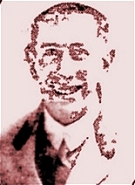 |
There is no definitely known time frame during which Fields and Seeley first encountered each other, but it was just as likely in Chicago as it was on the circuit, where they would have often crossed paths. He claimed she found him in a Chicago dive singing with a trio, and saved him from a life of performing in dives. Blossom was eventually taken enough with his style that she hired him as a backup vocalist to supplement her singing. The "however" was that he was to accompany her from the wings, rather than on stage. The gimmick worked, but from time to time Benny came out front to do a crooning solo, and soon the couple were doing duets together. Fields temperament may have also appealed to Blossom since he hardly seemed overbearing or explosive, as she claimed her other partners had been. Instead, he very accepting of her occasional volatility. The contrast in their voices, his mellow backing to her syncopated explosiveness, also grew notice from theater goers. It was all enough to convince Blossom to take on yet another stage partner in yet another marriage. The difference was that this one would last around 38 years, and would eventually see a reversal in their roles both on and off stage.
Blossom had a rather public divorce from Rube in 1920, claiming abandonment two years earlier. Just the same, the two would correspond to the end of her life, remaining friends. Given her history of marrying stage partners (including Patrick Curtin, Joseph Cahan and Rube), it was of no surprise to anybody when the following announcement appeared in the news in 1921:
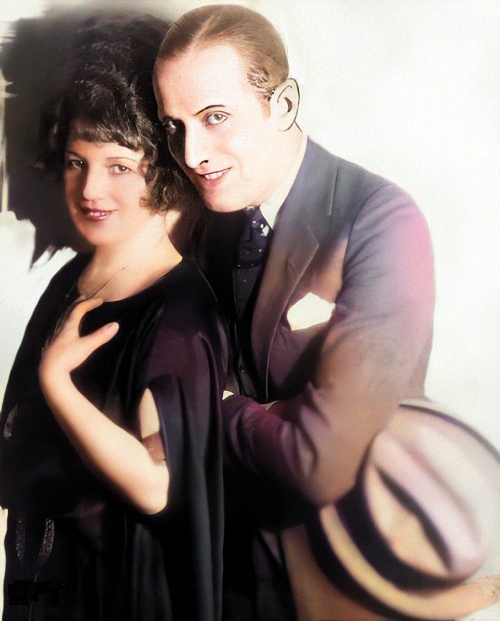 |
BLOSSOM SEELEY WEDS BENNY FIELDS
St. Paul., Minn., March 9, - Blossom Seeley, vaudeville actress, today announced her marriage to Benjamin E. Geisenfeld of Milwaukee, her dancing partner, known on the stage as Benny Fields. A civil ceremony was performed in Chicago three weeks ago and the religious ceremony was held here today. Miss Seeley formerly was the wife of Rube Marquard, major league pitcher.
Even as partners, Blossom was still the established star and was the draw for their bookings. Starting in 1921 she recorded some sides for Columbia records - just one the first year, but a total of 14 by 1926. She was one of the first female vocalists to record the jazz standard Way Down Yonder in New Orleans in 1922, the year it was first featured in the show Spice of 1922. It became a staple of her shows with Benny. Another number Blossom performed to great satisfaction at that time, albeit not on record, was Chicago (That Toddlin' Town), which also featured her on a cover shot.
The pair were an increasingly large draw throughout the early to mid-1920s. While Seeley and Fields, and more often they were becoming billed as Fields and Seeley, continued to grow in popularity, it was Blossom who was still making records. In 1924 she recorded four sides with The Georgians, considered to be one of the first true jazz orchestras. Seeley demonstrated some of her smoothest blues and jazz work on these four sides. Bennie, on the other hand, had become "King of Them All on the Radio," and was performing as a solo act from time to time while Blossom did her thing on stage elsewhere. But Bennie regarded Blossom as the true star. In a syndicated 1923 interview his rather extraordinary attitude and position were explained:
Blossom Seeley's name has been printed on vaudeville's posters in type of enormous dimensions throughout the current decade or so. And while the nimble-footed Benny Fields has had his publicity, it has amounted to a mere fraction of that enjoyed by his wife.
Accordingly, when he approaches a hotel register these days, he subscribes himself "Mr. Blossom Seeley Fields." "Why Not?" he enquires. "Isn't it natural for a husband to be proud enough of his wife's success to want to share her name?"
"Yes, why not?" echoes the sprightly Blossom. "But isn't it just like a man to want a fifty-fifty cut on his wife's fame? And there's complacency in her voice as she asks it. Apparently she not only is vastly satisfied, but very approving of the arrangement.
The biopic of Fields and (mostly) Seeley, Somebody Loves Me, is named after the George Gershwin song of the same title.
The story in the movie, that Gershwin wrote the piece for Seeley, is more likely a bit of folklore, as is much of the story line. That song was first included in a Broadway revue composed largely by Gershwin with lyricists Buddy G. De Sylva and Ballard Macdonald, George White's Scandals of 1924. There is no mention of Blossom being in that show, and no dedication of the piece to her, so this story is hard to substantiate. In fact, Seeley would not record the piece until an accompanying album was created for the movie in 1952, with Benny at her side. However, since she was acquainted with Gershwin, the story cannot be fully discounted either, so it remains as another mystery for now. Two songs that she did much to popularize in 1925 when they first came out were the still performed Yes Sir, That's My Baby (again often as a duet with Benny) and Alabamy Bound. In fact, even though Al Jolson was featured on cover of Alabamy Bound, and had also recorded it, Seeley's rendition eclipsed it, rising to the number 2 spot at one point.
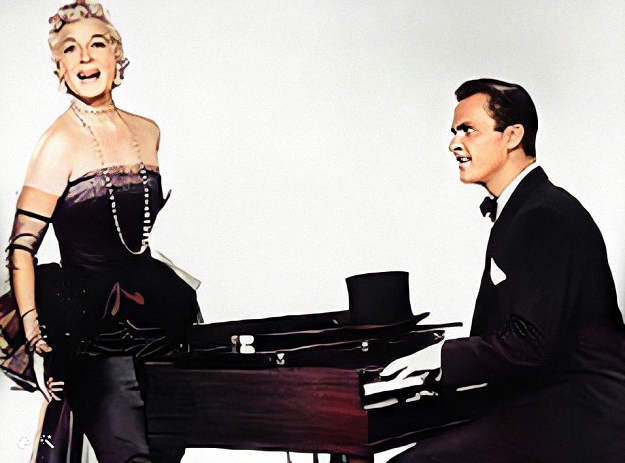 |
Vaudeville lived to a ripe old age, being a continuous form of entertainment for around a century. The year 1927 was regarded as the 100th anniversary of American vaudeville. It was only fitting that the top stars of vaudeville celebrate the event at what was considered the top vaudeville theater at that time, The Palace at 1564 Broadway. According to the New York Times of March 15, 1927, Blossom Seeley and Benny Fields (in that order) were the headliners for the celebration. Playing the Palace was considered to be the pinnacle of success for most performers (Al Jolson never did officially play the Palace), but headlining such a show was perhaps the only way to top that experience. Yet at that very moment there were plans being made in California that would both preserve many vaudeville acts for posterity, yet at the same time ensure its demise.
Warner Brothers had been producing synchronized sound shorts since mid-1926, and they were now working on their first sound feature film, The Jazz Singer.
Their system, which was a 16" record synchronized to a reel of film, was called Vitaphone. In order to help popularize the new technology in the best possible way, Warner Brothers spent a lot of 1926 through 1929 in New York recording various vaudeville acts to Vitaphone shorts. Since these acts were already established, the studio did not need to hire extra musicians, composers, script writers, etc., and the novelty of the sound films was enough to attract the entertainers without them demanding too much outlay. The Vitaphones not only demonstrated some of the best of vaudeville acts of the late 1920s, but they in many cases gave a plethora of reasons why such entertainment was doomed in light of the possibilities of feature films with sound as entertainment. Blossom and Benny made one of these Vitaphones of part of their act in May 1927 on a simple stage with two concert grand pianos played by "The Music Boxes," pianists Charles Bourne and Phil Ellis. Benny does his best to keep up on the jazzy opening, Hello Bluebird, on which Blossom demonstrates her strutting and finger snapping along with some fine jazz licks. They aptly demonstrate their subtle call and response duets on The Call of the South, which clearly shows Benny's smooth backing vocals. He pulls out the guitar for their finale, In a Little Spanish Town, which is considerably altered from a waltz into a jazzy dance tune. Then they bow and exit. Vitaphone #548, Blossom Seeley and Bennie Fields with The Music Boxes was eventually released in 1928 [currently available on a Vitaphone bonus disc with The Jazz Singer DVD] and was the only known performance they did for that studio.
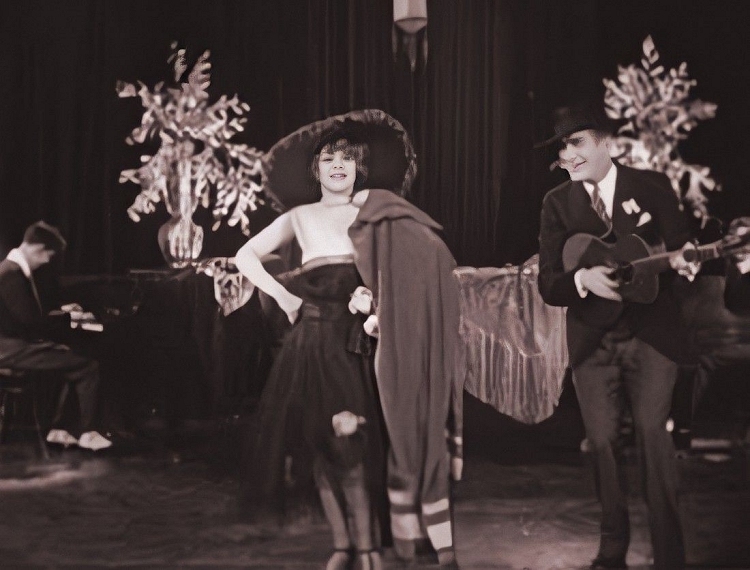 |
Blossom had a starring role again on Broadway in the Greenwich Village Follies of 1928, which ran from April through July for a respectable 128 performances. For the remainder of the year, she and Benny continued on the circuit. However, bookings were starting to diminish as more theaters throughout the country converted to sound, over 1800 of them by the end of 1928. Vaudeville in general saw smaller audiences in 1929, and when the Great Depression started to take hold in 1930, even the Palace Theater was offering more shows for less money in order to attract any kind of audience. Most of the vaudeville acts, such as Jack Benny, George Burns and Gracie Allen, and even Eddie Cantor, were moving towards film and away from the stage. Florenz Ziegfeld lost much of his considerable fortune in the 1929 crash on Wall Street, and his celebrated Follies was also in steep decline.
By 1933, Seeley and Fields decided to pursue disparate careers while remaining married. Benny's crooning style was well suited for radio, and he soon appeared several times on The Ziegfeld Follies of the Air and other New York based radio shows. Benny later remembered his first solo booking. He said, ""When I arrived at the theater, there was the billing on the marquee. In tiny letters it said 'Benny Fields' and below, in letters a foot high, it said 'formerly with Blossom Seeley.'" He quickly found his niche, performing with top hat and tails while gracefully gliding around the stage with his smooth vocals. That same year Blossom made three films that were well suited to her dynamic style, at least two of them specifically about Broadway and vaudeville. She and Benny appeared as themselves in a film hosted by Ed Sullivan titled Mr. Broadway. Following these films she faded into the background and supported Benny's continuing success.
Lean Times
By late 1935 Blossom and Benny followed many of their friends and peers out to Hollywood, but work was hard to come by.
They managed the occasional musical short or nostalgic appearance, but little else. It may have been at the insistence of their friend George Burns, who with his wife Gracie was now doing very well in Paramount produced pictures, that Fields was included in the 1936 film The Big Broadcast of 1937 starring Jack Benny. This was the third in a series of movies ironically about radio stars, and he did fairly well in it, crooning Here's Love in Your Eye for the microphone. Benny, now considered a capable soloist, recorded four sides for Decca Records that same year, and eight for the Variety label in 1937. Hollywood was not for the couple, however, and they went back to New York permanently by 1938.
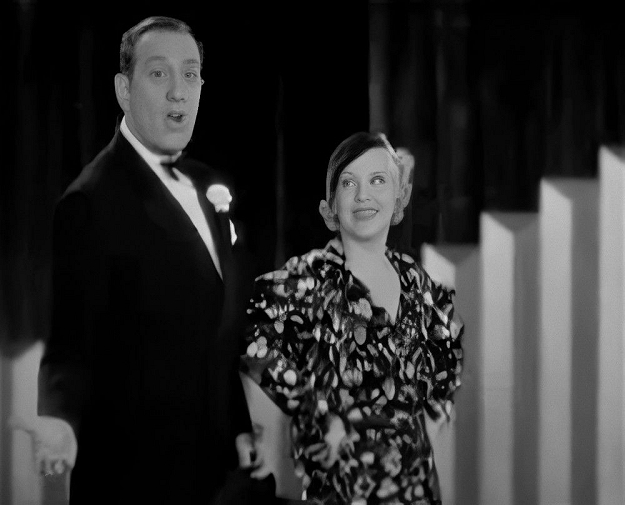 |
In 1941 Benny was hired by RCM Soundies to record four short Soundies, which were essentially the parents of today's music videos installed in Soundie jukeboxes around the country. This was essentially a 16mm film in a small case like a miniature jukebox that showed a rear-projected picture with sound, most of them three to four minutes long. Two of the Soundies were songs from The Big Broadcast of 1937. Copies of all of them are known to still exist today. After that, little was heard from Fields and Seeley for the next several years. According to his 1942 draft record, he and Blossom were living in the Warwick Hotel at 54th Street and 6th Avenue, with their employer being the famed William Morris Agency. He still listed both of his names, accumulatively as Benny Fields Geisenfeld.
Then in 1944, Producers Releasing Corporation (PRC), a small production company, crafted the film Minstrel Man around Benny's singular talent. They starred his as Dixie Boy Johnson, a minstrel show singer who became a Broadway star.
To add drama, they have his wife die as a result of childbirth on the opening night of his biggest show. Disillusioned, he leaves show business and his newborn daughter, who is raised by another show business couple. Eventually, Caroline (Judy Clark) grows up into a show business star, naming herself Dixie Girl Johnson after her dad. They have a reunion in the end and a big minstrel finale. It was directed by Joseph H. Lewis would take on the similarly dramatic The Jolson Story two years later.
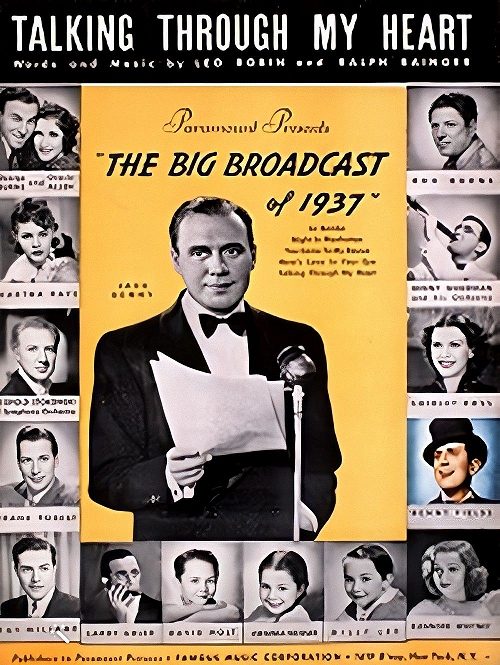 |
While Benny's acting did not receive many kudos, his singing performances did in the surprise hit. At least one critic described Benny as "a talent, voice, and personality the screen's been too long without." His career was revived for a time on radio, and PRC planned a follow up that would be the biographical story of Blossom and Benny, a project that eventually was shelved. The couple did push their own revival a bit, landing an album with MGM records in 1947. It featured songs dating back to the ragtime era, including a lovely duet of For Me and My Gal and By the Light of the Silvery Moon. But the clear highlight was Benny's solo rendition of The Lullaby of Broadway. For the most part, post-war entertainment in the late 1940s was struggling to find a center, and no particular genre stood out. The 1947 recordings were just a bit premature for the nostalgic revival that would start in 1950 on records, and was already underway in films.
So it was that by 1951 Blossom and Benny were struggling to survive in retirement. George and Gracie visited them in New York and found their current situation to be deplorable. Burns was already a major radio and film star who had made the transition to television with Gracie, and had some pull. So at the insistence of George Burns, and with his support, he sold Paramount Pictures on the idea of a Seeley and Fields biopic. Since the two successive Al Jolson biopics had done well, and MGM was cleaning up with nostalgic pictures by this time, it was not a hard sell. But as with many such films, Somebody Loves Me was a fictionalized version of their history. In most cases, such as with the Jerome Kern biopic Till the Clouds Roll By, many characters were melded into one and non-existent dilemmas were created to generate more of a dramatic story line. However, in the case of Somebody Loves Me, the real story was, for the most part, a little too saucy for audiences of that time. The end result was a picture starring Betty Hutton as Blossom and Ralph Meeker as Fields that had little resemblance to their actual life stories. In fact, Seeley was depicted as comparatively angelic and virginal, so much that Burns actually protested the treatment put on screen. Seeley, however, did not seem to mind. She responded to George's protests by noting that there was nothing she could do in advance about the future, but through such a portrayal she could at least fix her past. Blossom and Benny were also engaged by Decca Records to record eight tracks used in the film with their own voices, as Hutton's was of a somewhat different flavor. Meeker did not possess Benny's vocal talent, and his singing voice was dubbed by Pat Morgan, a credible match for the crooner's style.
Revival
In the mid-1950s, while visiting their friends in California, Benny and Blossom attended a house party thrown by George and Gracie, who were well known for their enjoyable affairs.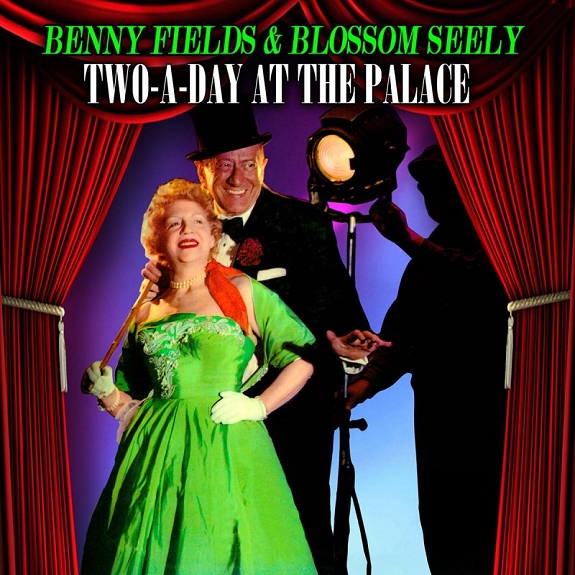 Several teenagers were also present, friends of the Burn's adopted children and the children of their friends. So it was perhaps natural that when George asked them to do some of their old vaudeville act that they were reluctant to do so, given that the audience hardly seemed proper for something so archaic. However, they finally honored Burns' request, and ended up with a captivated audience, proving that good entertainment by good entertainers can transcend time. This was enough to convince them to make another album together. Benny Fields and Blossom Seeley - Two a Day at the Palace was released on the Mercury label in 1957 during the height of 1950s nostalgia. It was enough to get them booked on the iconic Ed Sullivan Show, which had one of the largest audiences in the country. They also started making live and recorded radio appearances again. Sullivan asked them back on three more occasions in 1957 and 1958.
Several teenagers were also present, friends of the Burn's adopted children and the children of their friends. So it was perhaps natural that when George asked them to do some of their old vaudeville act that they were reluctant to do so, given that the audience hardly seemed proper for something so archaic. However, they finally honored Burns' request, and ended up with a captivated audience, proving that good entertainment by good entertainers can transcend time. This was enough to convince them to make another album together. Benny Fields and Blossom Seeley - Two a Day at the Palace was released on the Mercury label in 1957 during the height of 1950s nostalgia. It was enough to get them booked on the iconic Ed Sullivan Show, which had one of the largest audiences in the country. They also started making live and recorded radio appearances again. Sullivan asked them back on three more occasions in 1957 and 1958.
 Several teenagers were also present, friends of the Burn's adopted children and the children of their friends. So it was perhaps natural that when George asked them to do some of their old vaudeville act that they were reluctant to do so, given that the audience hardly seemed proper for something so archaic. However, they finally honored Burns' request, and ended up with a captivated audience, proving that good entertainment by good entertainers can transcend time. This was enough to convince them to make another album together. Benny Fields and Blossom Seeley - Two a Day at the Palace was released on the Mercury label in 1957 during the height of 1950s nostalgia. It was enough to get them booked on the iconic Ed Sullivan Show, which had one of the largest audiences in the country. They also started making live and recorded radio appearances again. Sullivan asked them back on three more occasions in 1957 and 1958.
Several teenagers were also present, friends of the Burn's adopted children and the children of their friends. So it was perhaps natural that when George asked them to do some of their old vaudeville act that they were reluctant to do so, given that the audience hardly seemed proper for something so archaic. However, they finally honored Burns' request, and ended up with a captivated audience, proving that good entertainment by good entertainers can transcend time. This was enough to convince them to make another album together. Benny Fields and Blossom Seeley - Two a Day at the Palace was released on the Mercury label in 1957 during the height of 1950s nostalgia. It was enough to get them booked on the iconic Ed Sullivan Show, which had one of the largest audiences in the country. They also started making live and recorded radio appearances again. Sullivan asked them back on three more occasions in 1957 and 1958.Benny recorded one more album recalling the days of vaudeville and minstrelsy. Benny Fields and His Minstrel Men was an all-star affair with Burns and Jack Benny, and younger stars Phil Silvers and Milton Berle. Burns and Benny were included as his oldest vaudeville friends, and they did a couple of funny vaudeville routines with each other on the album. A running gag had Benny warming up his violin before he was due on stage.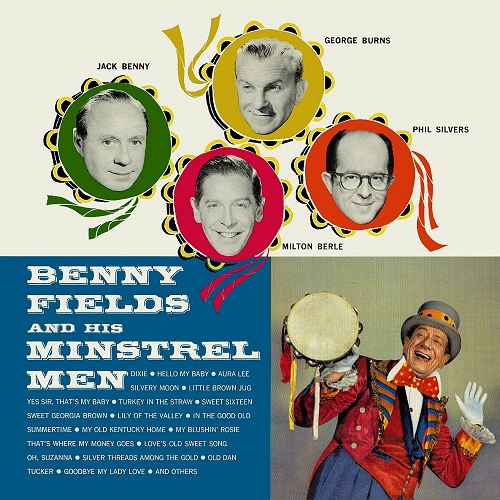 Silvers and Berle were most likely included as a selling point for the album, as both were popular television stars at that time. It should be noted that Berle did not record any tracks with the others, as while he was popular with the public, he was not so liked by many of his peers for brash behaviors and stealing of their material. Benny's crooning was clearly a highlight of this record, the first released on the short lived Colpix label, a subsidiary of Columbia Pictures. There was one glaring omission from Benny's minstrel album, that of veteran vaudevillian George Jessel, also not always popular with his peers. Jessel countered with an album in 1959 titled The Last of the Minstrel Men.
Silvers and Berle were most likely included as a selling point for the album, as both were popular television stars at that time. It should be noted that Berle did not record any tracks with the others, as while he was popular with the public, he was not so liked by many of his peers for brash behaviors and stealing of their material. Benny's crooning was clearly a highlight of this record, the first released on the short lived Colpix label, a subsidiary of Columbia Pictures. There was one glaring omission from Benny's minstrel album, that of veteran vaudevillian George Jessel, also not always popular with his peers. Jessel countered with an album in 1959 titled The Last of the Minstrel Men.
 Silvers and Berle were most likely included as a selling point for the album, as both were popular television stars at that time. It should be noted that Berle did not record any tracks with the others, as while he was popular with the public, he was not so liked by many of his peers for brash behaviors and stealing of their material. Benny's crooning was clearly a highlight of this record, the first released on the short lived Colpix label, a subsidiary of Columbia Pictures. There was one glaring omission from Benny's minstrel album, that of veteran vaudevillian George Jessel, also not always popular with his peers. Jessel countered with an album in 1959 titled The Last of the Minstrel Men.
Silvers and Berle were most likely included as a selling point for the album, as both were popular television stars at that time. It should be noted that Berle did not record any tracks with the others, as while he was popular with the public, he was not so liked by many of his peers for brash behaviors and stealing of their material. Benny's crooning was clearly a highlight of this record, the first released on the short lived Colpix label, a subsidiary of Columbia Pictures. There was one glaring omission from Benny's minstrel album, that of veteran vaudevillian George Jessel, also not always popular with his peers. Jessel countered with an album in 1959 titled The Last of the Minstrel Men.The two albums of 1957 and 1958 were successful enough that, added to the buzz the couple got from their Ed Sullivan appearances, a revival of their career seemed in order. They both appeared on the Gary Moore Show as themselves, along with Jack Benny, in March of 1959. During the summer they spent a month performing in Las Vegas, Nevada at the Desert Sands. With great plans for the 1959 to 1960 television season, and perhaps another recording in their future, Benny went to a rehearsal for Ed Sullivan to be broadcast on August 16. He was hospitalized that evening after suffering a massive heart attack, and died at age 65 on Sunday, the same day he was to be on the show. Benjamin Geisenfeld was buried at the Spring Hill Cemetery in his home town of Milwaukee, Wisconsin.
In his obituary there were quotes from Fields concerning his long life with Blossom. Describing the success of their marriage, Benny put it this way: "If two married people start getting jealous of each other's career, they don't have a marriage. They've just got a financial arrangement." Offering a rule for married people, Benny said, "One thing we always avoid is the word 'always,' - you know, 'you're always late,' or 'you're always griping' or 'you're always at the ball game.'" Fields added, "That's about the only rule for successful marriage I can think of offhand, except to pick a girl like Blossom."
Blossom was initially devastated at having lost the true love of her life after 38 years, but was able to recover sufficiently so that by November she made a solo appearance on Sullivan in honor of her late husband. She proved to be popular enough with her revival of days gone by, and her voice and performances still captivated audiences, but those audiences were diminishing in light of the social and musical changes of the mid-1960s, and her star finally faded for good. Blossom Seeley took her final bow in April 1974 at age 88. America had lost two true treasures, but they did leave a very real legacy behind of a life in ragtime and beyond, proving the durability of the genre and its stars.
Some interesting information on Seeley and Fields was taken from the Internet Broadway Database and the Internet Movie Database. A little of the history of Blossom and Benny in vaudeville came from Vaudeville, Old and New by Frank Cullen, Florence Hackman and Donald McNeilly. Some of the better stories on the couple, not all included here, can be found in the writings of their great friend George Burns.
The majority of the information here came from public records, individually cited newspaper accounts, magazine articles and reviews, investigative searches by the author, and period recording logs.

 Compositions
Compositions